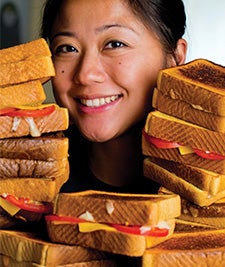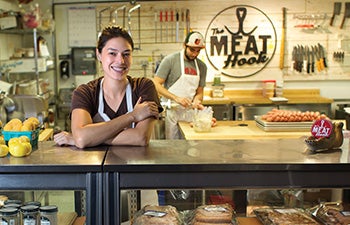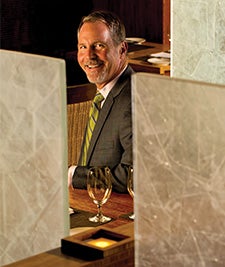Fearless Foodies
An English major becomes a grilled cheese goddess. A creative writing major finds her calling as a butcher. An international relations and German major is now assistant vice president of retail operations, overseeing the dining experience at USC. Guided by their love of food, these alumni took unconventional career paths and tasted success. They remember what Julia Child always said, “If you’re afraid of butter, use cream.”

After majoring in English, Heather Apraku cooked up the idea of a café that sells an unusual but compelling combination: grilled cheese and sweetened cereals. Photo by John Livzey.
Heather Apraku: Nostalgic Nosh
What do grilled cheese and cereal have in common? For starters, both are comfort foods steeped in nostalgia.
“Grilled cheese is probably the first sandwich you eat as a kid,” said Heather Apraku, co-owner of Mix n’ Munch Cereal Bar and Grilled Cheese Café in South Pasadena, California. “And you’re eating Cheerios in your high chair as soon as you get a few teeth.”
Many of us have memories of mom’s grilled cheese made with Kraft singles and digging for the prize in a box of Cap’n Crunch.
Only the creative mind of an English major could dream up this twist for a café. Combining Apraku’s obsession with cheese and her older sister Kim’s abiding love of cereal, the pair opened the café in 2010.
In addition to a menu of specialty sandwiches, patrons can customize their own, selecting from a wide assortment of breads, cheeses and toppings.
American cheese. White bread. Spam?
“That sandwich is delicious,” insisted Apraku, who earned her bachelor’s from USC Dornsife in 2005. “But people love it or hate it, there’s no middle ground.”
Maybe the Betsy Ross sounds more appetizing, with cheddar cheese, sliced apples and caramel sauce. Or Carol’s ChOP made with Chinese barbecue pork, pickled red onions and provolone?
“We even have some creative customers who make cereal sandwiches. When we first opened, a local elementary school kid created his American cheese and Cocoa Puff on white grilled sandwich. He would come in frequently for it.”
Apraku never imagined opening a restaurant, let alone one that specializes in the infinite permutations of grilled cheese and sweetened kids’ cereals.
But while writing her thesis for her master’s degree at USC Annenberg School for Communication and Journalism, the idea blossomed. For her thesis, she wrote a business plan for Mix n’ Munch.
“The concept just seemed like a fun idea. But as I worked on the business plan and did more and more research, it started to seem increasingly viable.”
Today, the café is thriving.
The eatery also offers grilled dessert sandwiches with additions like Nutella, peanut butter, fruit and Marshmallow Fluff. If sandwiches aren’t your thing, you can choose from among 20 cereals, a dozen mix-ins and a variety of milk options to create your own bowl.
“People get to be really creative here, which is fun,” Apraku said, while conceding that it isn’t exactly health food.
“That’s not the goal of this restaurant,” she said. “But we also have oatmeal bowls and yogurt parfaits, so you can make choices that are less gluttonous.”
If someone feels nostalgic for a certain cereal, this is their place, Apraku said.
“Adults are probably not going to buy themselves a whole box of Fruity Pebbles, but here they can have a little bowl.”
The café also offers old gems such as Quisp, a cereal introduced in 1965 now in limited distribution. The cereal is primarily purchased online.
“People come in and are so excited to see we carry that cereal,” Apraku said. “It’s a blast from the past.”
The ages and backgrounds of Apraku’s customers run the gamut — a testament to the fact that this food is for everyone, she said.
“We have lot of regulars that have been with us from the beginning, and it’s nice to see familiar faces. That’s why we picked South Pasadena — we both grew up and went to school here, and we know the vibe of the city and the community.”
The sisters also do in-store fundraisers for various community groups and high school classes, and donate gift certificates to a public library to support youth reading programs.
She remembers the challenges of getting her business up and running.
“It was sometimes overwhelming, with all these things popping up that you didn’t even know about,” she said. “But you just figure it out as you go. It’s the best way to learn.”
Thinking back to her undergraduate years, Apraku recalls two English faculty members in particular who had a great impact on her: Thomas Gustafson and Jim Kincaid.
“They made me think and question things in a different way. I enjoyed their nonconforming teaching styles in letting their students think for themselves, freely and creatively.”
The Trojan Family, she said, is an unbreakable bond.
“So often I meet fellow Trojans at the restaurant and we immediately click,” she said. “If I had not been an undergrad at USC, I would not have applied to graduate school at Annenberg, and there would likely be no Mix n’ Munch!”
She envisions opening more Mix n’ Munch cafés.
“I’d love to open one at, or around, USC,” she said. “We could hire USC students, and maybe they could even open their own franchises.”
Expert advice: Heather Apraku on The Perfect Grilled Cheese
First of all: butter! Butter is very important. And stay away from panini presses — I’m a big proponent of not smashing sandwiches. I’d rather just be patient and let them do their thing on a flat-top griddle or a frying pan if you’re at home.
Butter both sides of your bread and use medium heat to get the cheese really gooey. Grill the sandwich to a deep golden-brown, so that it’s crispy on the outside and melty on the inside. Do about three minutes on each side. As I tell my employees, there needs to be a perfect balance of melted cheese and golden-brown bread — you don’t want to burn the bread to get the cheese melted and gooey, but if it’s pretty on the outside and not gooey on the inside, you’ve failed!
I’m actually fine with using only cheese — give me cheddar on buttery bread and that’s just perfect. But I’ve never had a bad grilled cheese. You can get crazy with gruyère, brie, cheddar and Swiss and it will taste delicious. Grilled onions and mushrooms are great, and you can’t go wrong adding meats or veggies. Just heat the meat and veggies before adding them to the sandwich for the final minutes of grilling — unless it’s avocado, tomatoes or apples, of course.

Sara Bigelow left a career in culinary public relations to experience the food world hands on. Now she’s a trained butcher working in Brooklyn. Photo by Alison Bert.
Sara Bigelow: Steaking Her Claim
For many, an average workday begins by checking e-mail over a mug of hot coffee.
Sara Bigelow’s day often starts with a 100-pound slab of meat.
On delivery mornings, Bigelow pulls large cuts of raw meat, one by one, from big delivery bins and loads them onto a helper’s shoulders to haul into the butcher shop where she works.
“Butchering is definitely hard work,” she said. “It’s physically exhausting and your arms, legs and back all get sore. But I really like the delivery days. That physical exertion is what reminds you that you’re a butcher.”
Situated in the artisanal food mecca of Williamsburg in Brooklyn, The Meat Hook is a whole animal butcher shop specializing in locally sourced meat. Originating from family farms in New York state, the beef sold at the shop is grass-fed and the pork and lamb are pasture-raised.
“We don’t work like a grocery store, where you canorder, say, four boxes of chicken breasts,” said Bigelow, general manager of the shop. “We order whole animals, directly from the farm, and work with the farmers to make sure the product meets our specifications.”
The Los Angeles native had long been intrigued by the artisanal food industry.
After graduating from USC Dornsife in 2007 with a bachelor’s in creative writing, Bigelow moved to New York City and took a job in culinary public relations that drew on her interest in writing. But when she found herself taking a charcuterie class, she immediately felt in her element.
“The meat industry, unless you go digging for information, is not a very transparent field. You can go to pastry school, but I couldn’t find anything like that for butchering. At the time I was looking, it was still untrodden ground.”
Bigelow was willing to learn the ropes unpaid, but shops turned her away, maintaining that men were butchers and women were cashiers. Finally, at The Meat Hook, co-owner Tom Mylan allowed her to come in and observe, which got her foot in the door.
These days, schools charging thousands in tuition train students to become butchers, and many artisan shops have unpaid apprenticeship programs. But the field is still disproportionately male.
As a woman butcher, “I’m still in the minority in this country,” Bigelow said. “But recently I went to Barcelona and I’d say 90 percent of the butchers I saw were women. So it seems to be different in other places.”
The imbalance in the United States is improving, Bigelow said, noting that The Meat Hook has hired at least four full-time women staffers and plenty of female interns.
“The guys at my job find my being female a nonissue. To them, I’m just Sara who bugs them to get their stuff done on time and yells at them for messing around.”
A vegetarian in high school, Bigelow later began to miss meat — and for reasons beyond enjoying a good steak.
“Food is a really big part of my family, something we talk about and do together a lot, whether eating or cooking.” she said. “By not eating meat I would have lost out on things like cooking with my grandmother and learning the recipes that have been passed down in my family.”
Studying creative writing, Bigelow got the chance to see the world through the eyes of people who had chosen a path less ordinary.
“I think seeing that you could live a less conventional life as a poet or a writer gave me more courage than I would have otherwise had to pursue a career outside the corporate structure.”
Expert advice: Sara Bigelow on the Best Cut of Meat
There are a few things to consider when picking out meat for your meal. On the macro level, you may want to consider the origin of the animal — its diet, standard of living and the distance it traveled to get to your kitchen. Everyone has different priorities in terms of their food, but a good general rule is if your butcher can answer some basic questions about where your meat came from and what the animal ate, you’re on the right track to great meat.
On a micro, meal level, there really is no perfect cut of meat. Rather, each cooking method calls for its own cuts. Are you looking for a great piece of meat for the grill? A rib eye will do nicely, but so would a meaty pork shoulder chop, or skewers of beef heart (my personal favorite).
As a whole animal butcher, I’m always encouraging people to try something new. Want a steak that’s lean and tender, but cheaper than filet? Try a flatiron steak. Never heard of a flatiron steak? Seek out a butcher who’s familiar with more than the standard grocery store cuts and who can guide you through other parts of the animal. Try something new, and take advantage of that great L.A. weather that lets you grill outdoors all year round. I’m jealous.

Food industry veteran Kris Klinger directs the dining experience at USC. Soon, his job will extend to the forthcoming University Village and its array of eateries. Photo by John Livzey.
Kris Klinger: Mr. Hospitality
“Hey, Mr. Klinger!”
A hostess, bussers and waiters flash Kris Klinger smiles as he enters the restaurant and heads to a table on the patio.
He’s at Moreton Fig, a stylish eatery nestled beneath a twisting mass of branches belonging to the fig trees in the center of University Park campus. Opened four years ago, the restaurant features a menu of seasonal, farm-to-table cuisine.
“I don’t think most other campuses have anything like it, and we’re proud of that,” said Klinger, adding that most of the produce comes from local farmers. “The food really is amazing and we have a fantastic chef and crew.”
As assistant vice president of retail operations at USC, Klinger develops strategy and customer service programs, continually revitalizing the university’s dining program under the banner of USC Hospitality. This extends to the 42 residential dining halls, cafés, food stores, bars and restaurants at the University Park and Health Sciences campuses, as well as the Figueroa corridor.
The former U.S. Marine and food industry veteran, who joined USC in 2009, also oversees the Radisson Hotel Los Angeles Midtown at USC’s team and property. His group includes 106 managers, 700 hourly associates and 400 to 500 students, depending on the time of year.
Now his jurisdiction includes the hospitality portion of USC Village, an expansion project bringing in all-new student housing, academic space and retail shops just north of campus. It will include a bar and grill, cafés, a Starbucks and fast food options. Klinger is directly involved with the residential and retail planning and programming.
“In my job, my basic goal is to remove obstacles from everyone’s way,” he said between bites of the day’s special, a Greek gyro sandwich with tzatziki yogurt sauce and fries.
“I put a really good team together and give them the tools and direction they need, then I just let them go do what they have to do.”
Most broadly, USC Hospitality is committed to creating the best USC dining experience for all customers — professors, students, parents, alumni and staff as well as potential faculty and students visiting campus.
When Klinger first arrived, he removed communication barriers — maybe culinary wasn’t talking with operations — so that now everyone reports to the same person and shares the same vision and goals.
One of those goals is to try new things, and to be cutting edge and creative.
“We implemented Tapingo this year, which has been a huge success,” he said. “It’s app-based ordering, so students can order food on their smartphones and go pick it up after class.”
Klinger also reduced the number of food vendors at USC from 300 to 70, creating efficiency and strengthening existing relationships.
His team solicits feedback from students via surveys and focus groups. The recent creation of a marketing department has greatly expanded USC Hospitality’s social media presence.
“We provide food that students are familiar with, but wouldn’t probably expect in a residential hall,” he said, pointing out on-campus restaurants such as The Habit, California Pizza Kitchen, Lemonade and Nekter.
Klinger also plans to add more international food options while continuing to offer healthy choices, which have become increasingly in demand.
Outside the office, Klinger is a food lover and self-proclaimed cork dork.
“That’s another thing that attracted me to hospitality. In my first job as a waiter while in the Marines, there was a wine tasting component, and I was blown away by how you could get all these flavors out of a simple grape. It was amazing to discover how wine can really complement and enhance food.”
Klinger earned his bachelor’s in international relations and German at USC Dornsife in 1994, thinking he’d “work at an embassy or something cool like that.” His majors appear unrelated to his career choice, but Klinger draws from his undergraduate degree.
“At Dornsife, I learned to look at things differently, to consider all of the different angles and perspectives to understand how and why decisions were made in the past, and the impact of those decisions,” he said.
“In the hospitality business you deal with so many tastes, cultures and people. Connecting with people in this manner has helped me to navigate many of the challenges we face and overcome them.”
Expert advice: Kris Klinger on the Quintessential Multi-Course, West Coast Meal
For dessert, serve fresh berries with mint and a drizzle of honey along with a pour of 15-year-old Blandy’s Madeira. Bon appétit!
Read more stories from USC Dornsife Magazine‘s Fall 2014-Winter 2015 issue